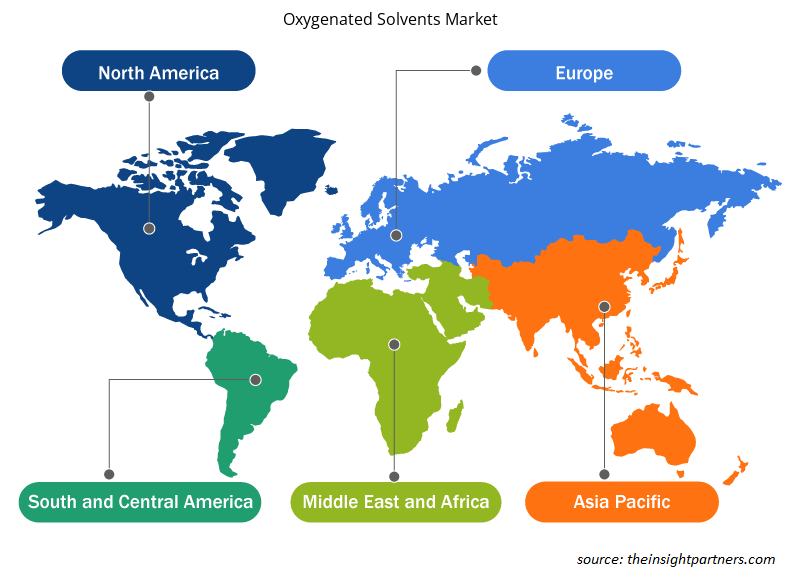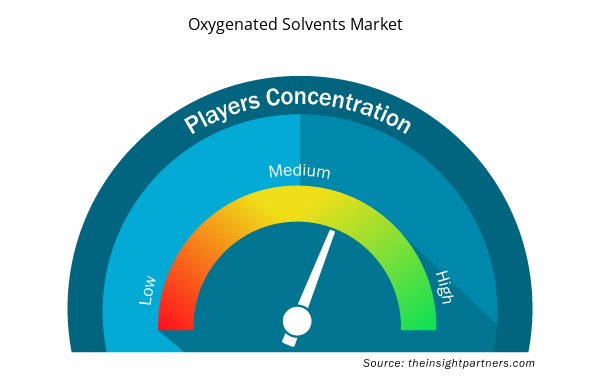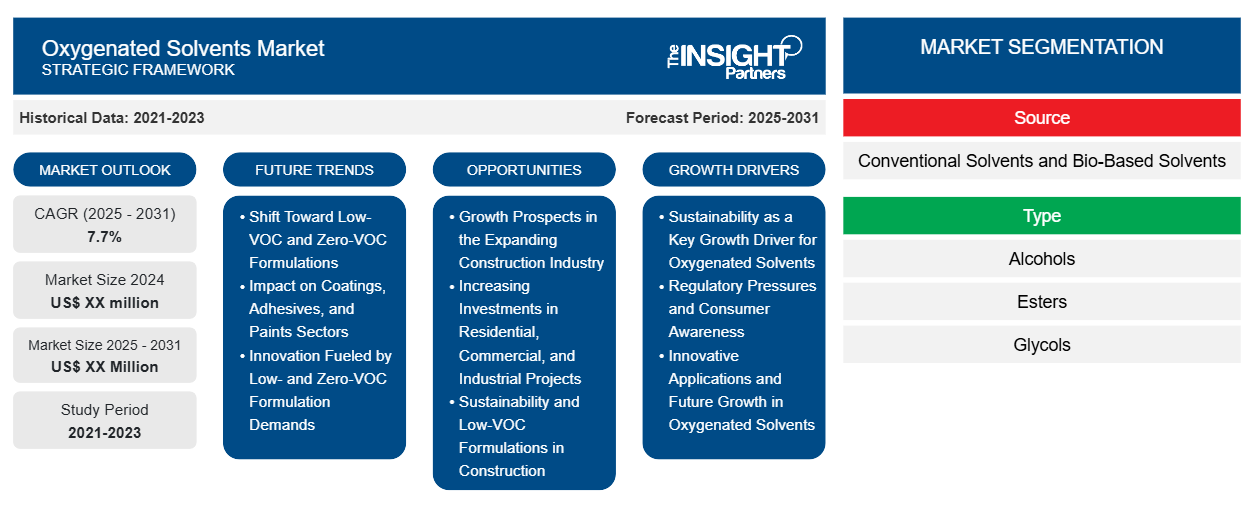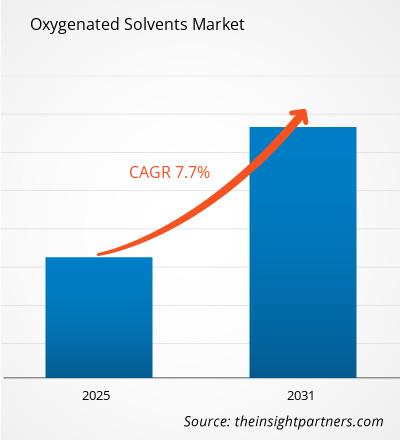Si prevede che il mercato dei solventi ossigenati registrerà un CAGR del 7,7% dal 2023 al 2031, con una dimensione di mercato in espansione da XX milioni di dollari nel 2023 a XX milioni di dollari entro il 2031.CAGR of 7.7% from 2023 to 2031, with a market size expanding from US$ XX million in 2023 to US$ XX Million by 2031.
Il report è segmentato per Fonte (Solventi convenzionali e Solventi di origine biologica). Il report è anche segmentato in base a Tipo (Alcoli, Esteri, Glicoli, Eteri di glicole, Chetoni e Altri) e Applicazione (Vernici e rivestimenti, Prodotti farmaceutici, Detergenti, Protezione delle colture e Altri). L'ambito del report copre 5 regioni: Nord America, Europa, Asia Pacifico, Medio Oriente e Africa, Sud e Centro America e Paesi chiave in ogni regione. L'analisi globale è ulteriormente suddivisa a livello regionale e nei principali Paesi. Il report offre il valore in USD per l'analisi e i segmenti di cui sopra.Glycols, Glycol Ethers, Ketones, and Others) and Application (Paints and Coatings, Pharmaceuticals, Cleaners, Crop Protection, and Others). The report scope covers 5 regions: North America, Europe, Asia Pacific, Middle East and Africa, and South and Central America and key countries under each region. The global analysis is further broken-down at regional level and major countries. The Report Offers the Value in USD for the above analysis and segments.
Scopo del rapporto
Il report Oxygenated Solvents Market di The Insight Partners mira a descrivere il panorama attuale e la crescita futura, i principali fattori trainanti, le sfide e le opportunità. Ciò fornirà spunti a vari stakeholder aziendali, come:
- Fornitori/produttori di tecnologia: per comprendere le dinamiche di mercato in evoluzione e conoscere le potenziali opportunità di crescita, consentendo loro di prendere decisioni strategiche informate.
- Investitori: condurre un'analisi completa delle tendenze in merito al tasso di crescita del mercato, alle proiezioni finanziarie del mercato e alle opportunità esistenti lungo la catena del valore.
- Enti di regolamentazione: regolamentano le politiche e le attività di controllo sul mercato allo scopo di ridurre al minimo gli abusi, preservare la fiducia degli investitori e sostenere l'integrità e la stabilità del mercato.
Segmentazione del mercato dei solventi ossigenati
Fonte
- Solventi convenzionali e solventi di origine biologica
Tipo
- Alcoli
- Esteri
- Glicoli
- Eteri glicolici
- Chetoni
Personalizza questo report in base alle tue esigenze
Riceverai la personalizzazione gratuita di qualsiasi report, comprese parti di questo report, o analisi a livello nazionale, pacchetto dati Excel, oltre a usufruire di grandi offerte e sconti per start-up e università
- Scopri le principali tendenze di mercato in questo rapporto.Questo campione GRATUITO includerà analisi di dati che spaziano dalle tendenze di mercato alle stime e alle previsioni.
Driver di crescita del mercato dei solventi ossigenati
- Sostenibilità come fattore chiave di crescita per i solventi ossigenati: l'industria cerca la sostenibilità come uno dei principali fattori di crescita per il mercato dei solventi ossigenati. Le preoccupazioni relative all'ambiente sono diventate così reali che le aziende cercano opzioni alternative ai solventi classici su cui fanno affidamento. Questi solventi ossigenati sono talvolta meno tossici e più degradabili, il che li rende utili in termini di questo obiettivo di sostenibilità stabilito dai produttori.
- Pressioni normative e consapevolezza dei consumatori: la sostenibilità non è più una tendenza ma un obbligo, spinto da maggiori pressioni normative e consapevolezza dei consumatori. Certi settori, come vernici, rivestimenti e adesivi, sono sotto esame per ridurre l'impatto ambientale. Offerte migliorate in questi segmenti insieme al supporto per una rigorosa conformità alle normative saranno uno dei principali motori di crescita.
- Applicazioni innovative e crescita futura nei solventi ossigenati: inoltre, le diverse applicazioni innovative dei solventi ossigenati in nuove formulazioni stanno tracciando la rotta verso applicazioni future. I solventi raggiungono caratteristiche di prestazioni migliorate come velocità di evaporazione e solubilità che determinano l'efficacia del prodotto. Con le aziende che continuano a innovare e a concentrarsi sulla sostenibilità, c'è una forte probabilità che la domanda di solventi ossigenati continui a crescere e le spinga ulteriormente verso il predominio.
Tendenze future del mercato dei solventi ossigenati
- Passaggio a formulazioni a basso e zero VOC: una delle tendenze più diffuse nel mercato dei solventi ossigenati è la tendenza verso formulazioni a basso e zero VOC. I principali fattori trainanti di questa tendenza sono le maggiori pressioni normative e la domanda dei consumatori di prodotti più ecologici. Con la pressione dell'industria per ridurre gli impatti ambientali, la domanda di tali solventi con meno emissioni pericolose sta aumentando a un ritmo molto rapido.
- Impatto sui settori di rivestimenti, adesivi e vernici: questa tendenza è piuttosto pronunciata nei settori correlati a rivestimenti, adesivi e vernici, in cui le emissioni di COV sono sottoposte a severi controlli. I produttori riformulano i loro prodotti utilizzando solventi ossigenati che soddisfano gli standard di bassi COV. Ciò non solo aiuta a rispettare queste normative, ma migliora anche la commerciabilità, attraendo consumatori attenti all'ambiente che apprezzano la sostenibilità.
- Innovazione alimentata da richieste di formulazione a basso e zero VOC: le tendenze di formulazione a basso e zero VOC stanno incoraggiando il potere innovativo nel settore. Le aziende stanno investendo molto in ricerca e sviluppo, creando nuove miscele di solventi ossigenati con prestazioni simili ma senza impatti negativi sull'ambiente. Questo flusso di innovazione accelererà sicuramente la crescita dei solventi ossigenati perché le aziende si stanno sforzando di bilanciare prestazioni e sostenibilità nelle offerte di prodotti.
Opportunità di mercato dei solventi ossigenati
- Prospettive di crescita nell'industria edile in espansione: le prospettive più promettenti per il mercato dei solventi ossigenati sono legate all'espansione dell'industria edile, in particolare nell'area Asia-Pacifico e in Medio Oriente. Man mano che i progetti di urbanizzazione e infrastrutturali diventano più vigorosi, la domanda di vernici e rivestimenti aumenta; la domanda di solventi ossigenati utilizzati in tali applicazioni aumenta direttamente.
- Aumento degli investimenti in progetti residenziali, commerciali e industriali: maggiori investimenti in progetti residenziali, commerciali e industriali alimentano la crescita nel settore delle costruzioni. Questo è un ambiente sostenibile per i produttori di solventi ossigenati in quanto sono componenti essenziali da utilizzare nella formulazione di vernici e rivestimenti ad alte prestazioni secondo i requisiti dei moderni professionisti del settore. Il miglioramento del prodotto in termini di tempo di asciugatura e durata può essere ottenuto tramite solventi ossigenati, che è uno dei motivi che aumentano i loro livelli di accettazione tra i professionisti del settore delle costruzioni.
- Sostenibilità e formulazioni a basso contenuto di COV nell'edilizia: sulla scia della sostenibilità, che sta diventando un punto focale nelle pratiche edilizie, è probabile che le formulazioni a basso contenuto di COV e basate sul verde offrano un'altra opportunità. In effetti, il mercato è consapevole del fatto che i solventi ossigenati potrebbero aiutare le aziende edili a soddisfare normative rigorose, consentendo loro di raggiungere consumatori attenti all'ambiente. E l'allineamento con gli obiettivi di sostenibilità fa ben sperare per una crescita marcata negli anni a venire.
Approfondimenti regionali sul mercato dei solventi ossigenati
Le tendenze regionali e i fattori che influenzano il mercato dei solventi ossigenati durante il periodo di previsione sono stati ampiamente spiegati dagli analisti di Insight Partners. Questa sezione discute anche i segmenti e la geografia del mercato dei solventi ossigenati in Nord America, Europa, Asia Pacifico, Medio Oriente e Africa e America meridionale e centrale.

- Ottieni i dati specifici regionali per il mercato dei solventi ossigenati
Ambito del rapporto di mercato sui solventi ossigenati
| Attributo del report | Dettagli |
|---|---|
| Dimensioni del mercato nel 2023 | XX milioni di dollari USA |
| Dimensioni del mercato entro il 2031 | XX milioni di dollari USA |
| CAGR globale (2023-2031) | 7,7% |
| Dati storici | 2021-2022 |
| Periodo di previsione | 2024-2031 |
| Segmenti coperti | Per fonte
|
| Regioni e Paesi coperti | America del Nord
|
| Leader di mercato e profili aziendali chiave |
|
Densità degli attori del mercato dei solventi ossigenati: comprendere il suo impatto sulle dinamiche aziendali
Il mercato dei solventi ossigenati sta crescendo rapidamente, spinto dalla crescente domanda degli utenti finali dovuta a fattori quali l'evoluzione delle preferenze dei consumatori, i progressi tecnologici e una maggiore consapevolezza dei benefici del prodotto. Con l'aumento della domanda, le aziende stanno ampliando le loro offerte, innovando per soddisfare le esigenze dei consumatori e capitalizzando sulle tendenze emergenti, il che alimenta ulteriormente la crescita del mercato.
La densità degli operatori di mercato si riferisce alla distribuzione di aziende o società che operano in un particolare mercato o settore. Indica quanti concorrenti (operatori di mercato) sono presenti in un dato spazio di mercato in relazione alle sue dimensioni o al valore di mercato totale.
Le principali aziende che operano nel mercato dei solventi ossigenati sono:
- Società Basf Se
- Società per azioni Dowdupont Inc.
- Società chimica Eastman
- ExxonMobil Corporation
- Ineo
Disclaimer : le aziende elencate sopra non sono classificate secondo un ordine particolare.

- Ottieni una panoramica dei principali attori del mercato dei solventi ossigenati
Punti di forza chiave
- Copertura completa: il rapporto copre in modo completo l'analisi di prodotti, servizi, tipologie e utenti finali del mercato dei solventi ossigenati, fornendo una panoramica olistica.
- Analisi degli esperti: il rapporto è compilato sulla base della conoscenza approfondita di esperti e analisti del settore.
- Informazioni aggiornate: il rapporto garantisce la pertinenza aziendale grazie alla copertura di informazioni recenti e tendenze nei dati.
- Opzioni di personalizzazione: questo report può essere personalizzato per soddisfare le esigenze specifiche del cliente e adattarsi in modo appropriato alle strategie aziendali.
Il rapporto di ricerca sul mercato dei solventi ossigenati può quindi aiutare a guidare il percorso di decodifica e comprensione dello scenario del settore e delle prospettive di crescita. Sebbene possano esserci alcune preoccupazioni valide, i vantaggi complessivi di questo rapporto tendono a superare gli svantaggi.
- Analisi storica (2 anni), anno base, previsione (7 anni) con CAGR
- Analisi PEST e SWOT
- Valore/volume delle dimensioni del mercato - Globale, regionale, nazionale
- Industria e panorama competitivo
- Set di dati Excel


- Machine Condition Monitoring Market
- Rare Neurological Disease Treatment Market
- Foot Orthotic Insoles Market
- Hair Extensions Market
- Wind Turbine Composites Market
- Vision Guided Robotics Software Market
- Long Read Sequencing Market
- Military Rubber Tracks Market
- Piling Machines Market
- Resistance Bands Market

Report Coverage
Revenue forecast, Company Analysis, Industry landscape, Growth factors, and Trends

Segment Covered
This text is related
to segments covered.

Regional Scope
North America, Europe, Asia Pacific, Middle East & Africa, South & Central America

Country Scope
This text is related
to country scope.
Domande frequenti
Based on geography, Asia Pacific is expected to register the fastest CAGR from 2023 to 2031.
The report can be delivered in PDF/Word format, we can also share excel data sheet based on request.
Growth in the construction industry is one of the key opportunities for the market growth.
Arkema SA, Monument Chemical Inc, Celanese Corporation, Huntsman Corporation, Solvay SA, LG Chem Ltd, Sasol SA, Reliance Industries, Mitsubishi Chemical Corporation, and Vertec Biosolvents are among the leading players operating in the oxygenated solvents market.
Increasing emphasis on sustainability within various industries is driving the market growth
The Oxygenated Solvents Market is estimated to witness a CAGR of 7.7% from 2023 to 2031
Trends and growth analysis reports related to Chemicals and Materials : READ MORE..
1. Basf Se Corporation
2. Dowdupont Inc.
3. Eastman Chemical Company
4. Exxon Mobil Corporation
5. Ineos
6. Monument Chemical Inc.
7. Petroliam Nasional Berhad
8. Royal Dutch Shell Plc.
9. Sinopec Corporation
10. Solvay Sa
The Insight Partners performs research in 4 major stages: Data Collection & Secondary Research, Primary Research, Data Analysis and Data Triangulation & Final Review.
- Data Collection and Secondary Research:
As a market research and consulting firm operating from a decade, we have published and advised several client across the globe. First step for any study will start with an assessment of currently available data and insights from existing reports. Further, historical and current market information is collected from Investor Presentations, Annual Reports, SEC Filings, etc., and other information related to company’s performance and market positioning are gathered from Paid Databases (Factiva, Hoovers, and Reuters) and various other publications available in public domain.
Several associations trade associates, technical forums, institutes, societies and organization are accessed to gain technical as well as market related insights through their publications such as research papers, blogs and press releases related to the studies are referred to get cues about the market. Further, white papers, journals, magazines, and other news articles published in last 3 years are scrutinized and analyzed to understand the current market trends.
- Primary Research:
The primarily interview analysis comprise of data obtained from industry participants interview and answers to survey questions gathered by in-house primary team.
For primary research, interviews are conducted with industry experts/CEOs/Marketing Managers/VPs/Subject Matter Experts from both demand and supply side to get a 360-degree view of the market. The primary team conducts several interviews based on the complexity of the markets to understand the various market trends and dynamics which makes research more credible and precise.
A typical research interview fulfils the following functions:
- Provides first-hand information on the market size, market trends, growth trends, competitive landscape, and outlook
- Validates and strengthens in-house secondary research findings
- Develops the analysis team’s expertise and market understanding
Primary research involves email interactions and telephone interviews for each market, category, segment, and sub-segment across geographies. The participants who typically take part in such a process include, but are not limited to:
- Industry participants: VPs, business development managers, market intelligence managers and national sales managers
- Outside experts: Valuation experts, research analysts and key opinion leaders specializing in the electronics and semiconductor industry.
Below is the breakup of our primary respondents by company, designation, and region:

Once we receive the confirmation from primary research sources or primary respondents, we finalize the base year market estimation and forecast the data as per the macroeconomic and microeconomic factors assessed during data collection.
- Data Analysis:
Once data is validated through both secondary as well as primary respondents, we finalize the market estimations by hypothesis formulation and factor analysis at regional and country level.
- Macro-Economic Factor Analysis:
We analyse macroeconomic indicators such the gross domestic product (GDP), increase in the demand for goods and services across industries, technological advancement, regional economic growth, governmental policies, the influence of COVID-19, PEST analysis, and other aspects. This analysis aids in setting benchmarks for various nations/regions and approximating market splits. Additionally, the general trend of the aforementioned components aid in determining the market's development possibilities.
- Country Level Data:
Various factors that are especially aligned to the country are taken into account to determine the market size for a certain area and country, including the presence of vendors, such as headquarters and offices, the country's GDP, demand patterns, and industry growth. To comprehend the market dynamics for the nation, a number of growth variables, inhibitors, application areas, and current market trends are researched. The aforementioned elements aid in determining the country's overall market's growth potential.
- Company Profile:
The “Table of Contents” is formulated by listing and analyzing more than 25 - 30 companies operating in the market ecosystem across geographies. However, we profile only 10 companies as a standard practice in our syndicate reports. These 10 companies comprise leading, emerging, and regional players. Nonetheless, our analysis is not restricted to the 10 listed companies, we also analyze other companies present in the market to develop a holistic view and understand the prevailing trends. The “Company Profiles” section in the report covers key facts, business description, products & services, financial information, SWOT analysis, and key developments. The financial information presented is extracted from the annual reports and official documents of the publicly listed companies. Upon collecting the information for the sections of respective companies, we verify them via various primary sources and then compile the data in respective company profiles. The company level information helps us in deriving the base number as well as in forecasting the market size.
- Developing Base Number:
Aggregation of sales statistics (2020-2022) and macro-economic factor, and other secondary and primary research insights are utilized to arrive at base number and related market shares for 2022. The data gaps are identified in this step and relevant market data is analyzed, collected from paid primary interviews or databases. On finalizing the base year market size, forecasts are developed on the basis of macro-economic, industry and market growth factors and company level analysis.
- Data Triangulation and Final Review:
The market findings and base year market size calculations are validated from supply as well as demand side. Demand side validations are based on macro-economic factor analysis and benchmarks for respective regions and countries. In case of supply side validations, revenues of major companies are estimated (in case not available) based on industry benchmark, approximate number of employees, product portfolio, and primary interviews revenues are gathered. Further revenue from target product/service segment is assessed to avoid overshooting of market statistics. In case of heavy deviations between supply and demand side values, all thes steps are repeated to achieve synchronization.
We follow an iterative model, wherein we share our research findings with Subject Matter Experts (SME’s) and Key Opinion Leaders (KOLs) until consensus view of the market is not formulated – this model negates any drastic deviation in the opinions of experts. Only validated and universally acceptable research findings are quoted in our reports.
We have important check points that we use to validate our research findings – which we call – data triangulation, where we validate the information, we generate from secondary sources with primary interviews and then we re-validate with our internal data bases and Subject matter experts. This comprehensive model enables us to deliver high quality, reliable data in shortest possible time.


 Ottieni un campione gratuito per questo repot
Ottieni un campione gratuito per questo repot